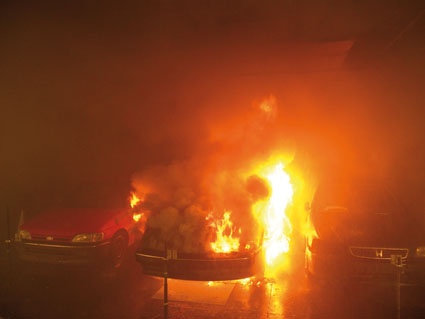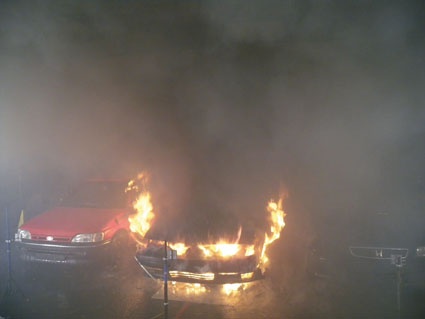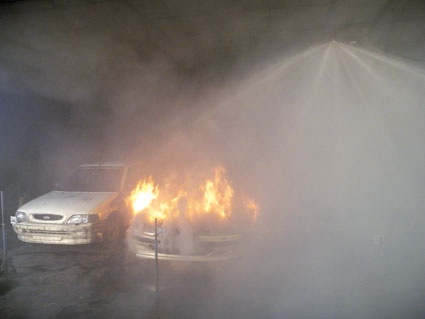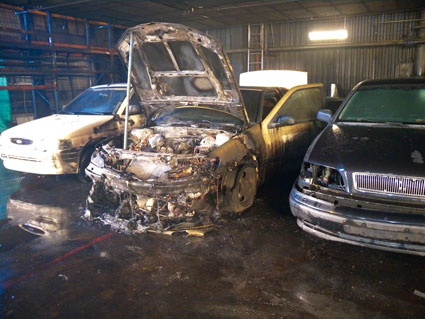Water Mist Protection of Parking Garages
Fires in parking garages are becoming increasingly common, often resulting in serious damage in the form of direct fire damage and smoke damage. In addition, arson is very common. ...




Fires in parking garages are becoming increasingly common, often resulting in serious damage in the form of direct fire damage and smoke damage. In addition, arson is very common. On behalf of Danfoss Semco A/S Fire Protection, SP has tested a water mist system for protecting parking garages.
Standardised Test Method
The tests were carried out in accordance with a standardised test method developed by VdS Schadenverhütung in Germany. VdS is an independent international institute that tests and certifies fire protection and safety equipment. All requirements and standards are developed in conjunction with the insurance industry and international organisations.
The test method for parking garages simulates real conditions in that ordinary passenger cars are used. In this case, scrapped vehicles were used, with all cars being of medium-size type, manufactured in the middle of the 1990s. Both saloons and hatchbacks were used in the tests.
Three cars were parked side by side, about 60 cm apart, under a suspended ceiling. The fire was started by two pans of heptane, which were placed underneath the centre car and ignited. This gave the fire a relatively fierce start, quickly involving the underneath of the car, all the tyres and the engine compartment. In most cases, the fire also spread to the inside of the car via the luggage compartment. It was, however, uncommon for the windscreen, side windows or rear screen to rupture.
Comparison Tests with Ordinary Sprinklers
The requirements in the test method are based on the system being tested having much the same efficacy as that of traditional sprinklers. The first tests were therefore performed using sprinklers, and measuring the temperature at ceiling level above the fire using thermocouples. The temperature was also measured using Plate Thermometers in front of and behind the vehicles, which gave an idea of the risk of the fire spreading. In addition, the body surface temperatures of the cars on each side were also measured. Together with visual assessment of any fire damage, this provides an idea of the risk of the spread of fire between the cars. The centre car was positioned so that it was either directly under one sprinkler or between four sprinklers.
Fast Response Nozzles Were Used
The water mist system developed by Danfoss Semco A/S Fire Protection has the same design as that of a traditional sprinkler system. The nozzles are closed by a glass bulb, and automatically activated, one by one, by the heat from the fire. However, they are activated at a much earlier stage of the fire than is the case with traditional sprinklers, as the bulbs have a lower nominal activation temperature (of 57 °C as compared with 68 °C) and a lower RTI value (34 m½s½ as compared with about 90 m½s½). The water pressure in the system was 60 bar.
Convincing Results
The trials with the traditional sprinklers show that they perform well against vehicle fires. As, in principle, the fire is completely shielded from the sprinkler water by the car body, the main effect of the sprinklers is to prevent the spread of fire and to reduce the temperature at ceiling level. The fire did not spread to any of the cars beside the burning car in any of the tests. The average temperature at ceiling level did not exceed about 100°C. Figures 1 and 2 show one of the tests with traditional sprinklers, just before the first sprinkler activated and about five minutes later.
The results from the water mist system were comparable with those of the traditional sprinkler system, despite the fact that the distance between the nozzles was greater. In addition, the water discharge density was considerably less. As with the traditional system, the water mist system did not reach the primary seat of the fire underneath the car. However, the system reduces the ceiling level temperature better than does the sprinkler system, due to the higher cooling capacity of the smaller water droplets. The spread of fire between the vehicles was prevented thanks to the direct cooling (wetting) of the cars, and to the good performance of the small water droplets in absorbing thermal radiation. Figure 3 shows the fire in one of the vehicles seconds after activation of the first nozzle, while Figure 4 shows the fire damage after the test.
The conclusions from the tests are that a correctly sized and installed water mist system provides a level of protection that is fully comparable with that of a traditional sprinkler system when dealing with this type of fire risk. In addition, the distance between nozzles can be increased and the total water flow can be reduced.
Business Partner
SP Technical Research Institute
Germany
most read

GIT SECURITY AWARD 2026 - The winners have been announced!
GIT SECURITY AWARD 2026: The best safety and security solutions of the year - now an overview of all winners

Is Your Venue Ready for Martyn’s Law?
Martyn’s Law demands stronger security by 2027. Is your venue prepared to protect and respond?

Five Questions with Intersec Saudi Arabia Exhibition Director Riham Sedik
Intersec Saudi Arabia 2025: Exclusive Insights with Riham Sedik, Exhibition Director

Security management, building security & perimeter protection: the winners of category E at the GIT SECURITY AWARD 2026
GIT SECURITY AWARD 2026: Security management, building security & perimeter protection - an overview of the most innovative solutions

Integrated and Futureproof: Traka’s Next Chapter
Interview with Stefni Oliver on Traka’s Vision for the Future








